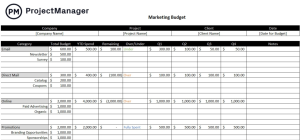HOW CMOs PREPARE THEIR MARKETING BUDGET
The process of getting your business’s brand, product or service known to its potential buyers costs more than what you would imagine. A breakdown of the amount of money a business intends to spend on various marketing tasks in a certain period (from a quarter to a year) is called its marketing budget. It is prepared and proposed to the chief financial officer (CFO) by the chief marketing officer (CMO). Wrong decisions can make marketing costs shoot up like a rocket without even getting the brand, product or service known by its target group. That is why a CMO’s job is crucial for a business, whether it’s for a small business marketing plan or a large one.
Read on to find out everything you need to know about the planning and preparing of marketing budgets.
What Does a Marketing Budget Typically Include?
Marketing budgets include breakdowns of the costs incurred by a business in order to develop, promote, market and sell its brand and products or services.
A few common examples of marketing costs are:
- Subscriptions & Purchases of Software and AI Tools for Marketing <Add link to previous blog>
- Hiring New Personnel, Freelancers and Marketing Agencies
- Media Plan & Media Buying
- Advertising Budget or Paid Promotional Budget
- Content Creation
- Email Marketing
- Search Engine Optimization (SEO)
- Influencer Marketing
- Product Launches and Expos
When outlining a marketing and advertising budget, a CMO’s main goal is to allocate appropriate funds for such departments so that the total marketing spends are minimized while ensuring the sufficient and effective promotion of brands, products and services.

How Do CMOs Plan Their Marketing Budget?
Wish to plan your marketing and promotional budget like successful CMOs? Here are the steps they take to get the job done:
- Set Marketing Goals & Objectives
Set your marketing goal. For instance – increasing brand awareness, earning more subscribers or followers, increasing leads or boosting sales. What’s important is setting marketing goals and objectives that are specific, relevant, time-bound and measurable. So, instead of setting a goal like ‘increase sales’ that doesn’t give a precise target to achieve, have a goal like ‘Achieve a 20% increase in sales by the year’s end’, which is easy to measure and plan a budget for.
For marketing budgets, then create sales funnels and short- as well as long-term goals and decide their key performance indicators (KPIs) to track performance.
- Conduct Thorough Market Research
Experienced CMOs make sure they don’t step into a marketplace without an in-depth understanding of the market. Conduct detailed market research to get a crystal-clear picture of the TG. That includes demographics, financial conditions, wants and needs, etc. CMOs also thoroughly analyze their business’s competitors. List specifically what your brand has in common with its competitors and what sets it apart. When you understand how your business stacks up against the competitors, you can establish better strategies to compete with them.
CMOs usually gauge the competition’s performance by conducting a thorough competitor analysis. Some competitor analysis tools like CompetitorSpyFX are helpful for analyzing your competition’s campaigns and offering ideas for your own campaigns. It’s also very helpful to make use of social media monitoring tools to track what’s being said about your competitors online.
- Find Out The Customers’ Journey
The customer’s journey of your business is the steps your TG takes to go from being prospects to paying customers. Knowing the customer’s journey helps CMOs understand the impact and effectiveness of their marketing campaigns on their TG. And therefore set more realistic and specific goals and marketing budgets to reach potential customers.
To know the customer’s journey, a CMOs would usually find answers to questions such as:
- How do people typically discover their products?
- What should those people know about the products to make a purchase?
- How many store/website visits does their business get per month?
- How many leads is the business generating per month?
- How many of those leads actually convert and become paying customers?
- How much does it cost the business to generate new leads and convert them to customers?
- What is usually the revenue or value of each lead?
The answers to these questions point out the marketing tactics do and do not work, helping decide where the marketing goals need to be altered and what the budget needs to be focused on.
- Choose Marketing Channels Wisely
Seasoned CMOs know that their marketing communication will be effective on some channels and not all – according to the lifestyle, online behavior and preferences of the audience they’re trying to target. It needs some research to predict if their TG is swayed by email, social or content marketing channels, for example. Running A/B tests on multiple marketing channels before allocating budgets for them is a very effective strategy to save costs and time. Creating your brand’s buyer persona also goes a long way in finding out the channels your potential customers use. Because, for that, you need to conduct in-depth research on your existing customer base, including their online and offline buying tendencies for various products and services.
- Estimate Marketing Costs and Align Them With Priorities
This is where the math comes in a media plan or media buying process. CMOs determine the possible cost for achieving each of their marketing goals. Using historical data from the previous marketing campaigns or refering to the industry’s averages, one must estimate:
- The average cost per new lead
- The average cost per website visit or impression
- The average cost per conversion
Once the marketing costs are estimated, make sure they’re aligned with the priorities among your marketing objectives. High-priority tasks must obviously get allocated more of the budget than the rest.
- Awareness of Hidden Costs
One of the biggest benefits of maintaining budget spreadsheets is that they help avoid an end-of-the-year or end-of-the-quarter crisis with people questioning and wondering what all the budget was spent on. Oftenly, unanticipated spends force CMOs to use up the money they never planned on spending. Consider the example of product marketing. When marketers allocate product marketing budgets, they may think in terms of launches and promotional activities of products. They may therefore forget that product marketing needs more than just promotional activities. Foresighted CMOs therefore always allocate some of the budget for hidden costs their marketing team may not have considered.
- Predict and Plan to Keep Track of ROI
After planning marketing budgets, CMOs find out whether their budgeting strategy benefited them in order to plan future well-informed budgets. Measuring the return on investment (ROI) is the neatest way to do it. If the budget spent on a particular marketing channel results in a high ROI, CMOs may dare to increase the money they allocate for that channel in the next budget they prepare – and be able to justify it to the CFO. If the money allocated went nowhere, it can be spent on a better channel in the next quarter or year.
Most of the initial budgeting process is based on projections. However, after launching marketing campaigns, marketers have to track their progress towards their decided goals. And according to that progress, CMOs may have to take calls to modify the marketing strategy to make the most of their marketing spends.
Data-driven marketing is one of the biggest marketing trends for 2023. And that’s how CMOs track ROI while running their campaigns.
Data-driven marketers calculate their projected ROI while budgeting and adjust their efforts after evaluating actual returns.
What Is Marketing Budget Allocation?
Marketing budget allocation is simply the maximum amount of money a CMO can allocate for a marketing plan. It is the total funding allocated for each and every expenditure line combined. Therefore, it is the financial limit or figure which a marketing budget must never exceed.
This money needs to make the brand’s marketing communication reach its target group and generate leads, conversions and other KPIs that indicate a satisfactory ROI for the business. Deciding a marketing budget allocation is crucial for a CMO because of the risk of spending more than the revenues of their business into just the marketing.
Why and How Do CMOs Track Their Marketing Budget?
CMOs put a significant amount of time and effort into planning their marketing budgets. It only makes it even more important for them to track their results. Marketing budgets are not always carved in stone. They are documents that are frequently reviewed and revised.
Once a CMO sets the baseline for a marketing budget, they can adjust the scope of their marketing campaign or schedules to make up for additional spends. In the present age, most CMOs get real-time data from software like Spendesk to track their marketing spends against their budget.
Marketing Budget Template and Sample
CMOs usually use paid tools like ProjectManager for planning and creating their marketing budgets. However, if you do not need real-time data, you can download ProjectManager’s free marketing budget template for Excel and manually input all the required financial data for your marketing budget.
Here’s a sample to see what it looks like:

Now that you know how top CMOs do their budgeting, you can start with yours yourself. Need help creating your small business marketing plan? Allow Pop Communications to do it for you. Have a look at our wide range of digital marketing services as well. They’re sure to come in handy when you need to execute your campaigns.
Get in touch with us anytime:
Email: [email protected] | Call: +1 647 846 6601
Happy marketing!


